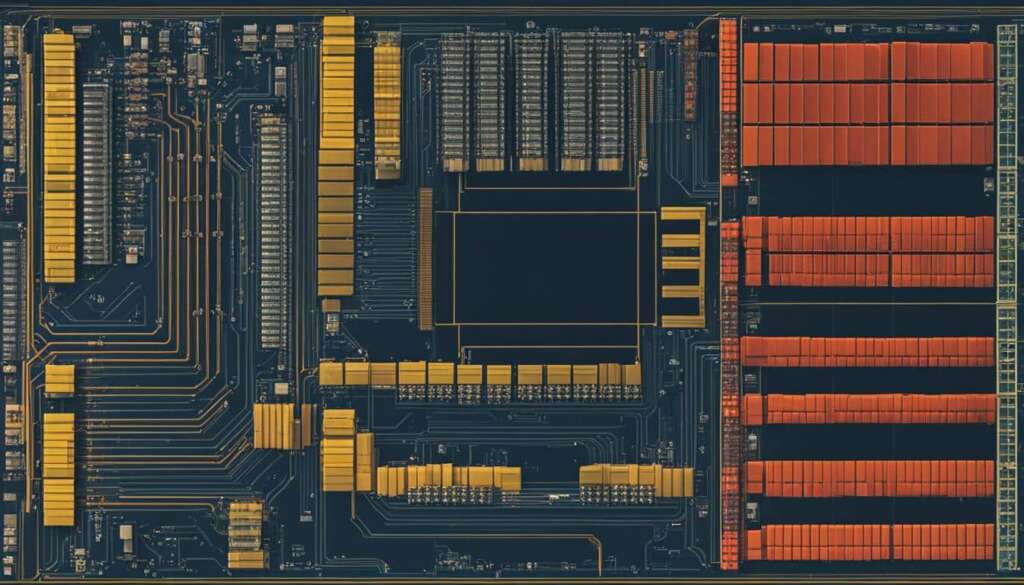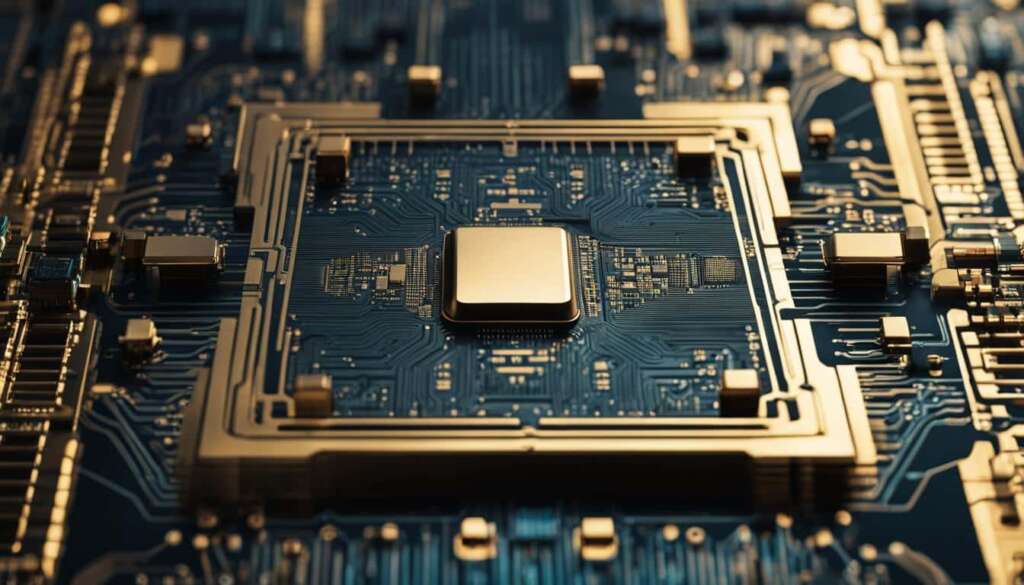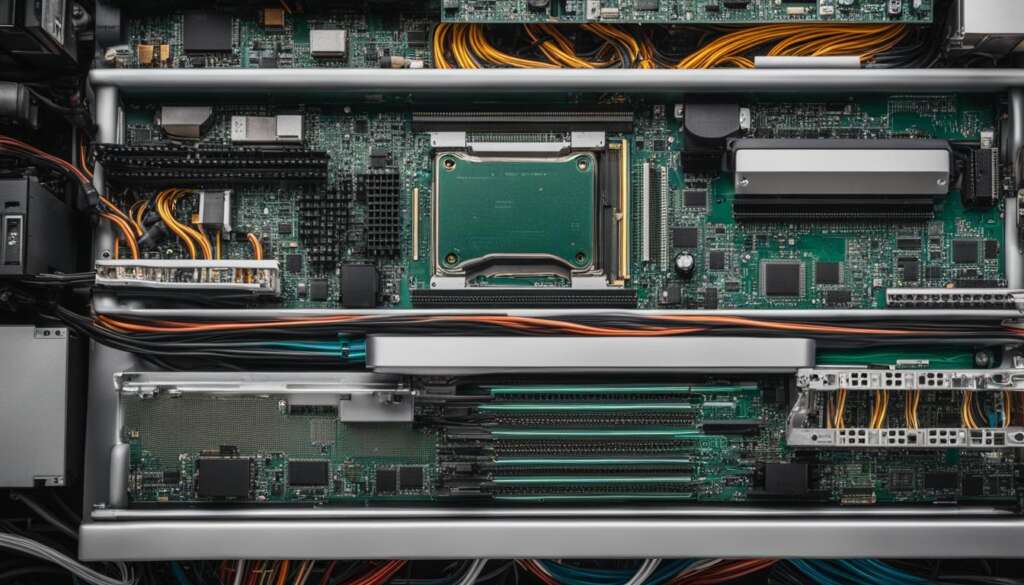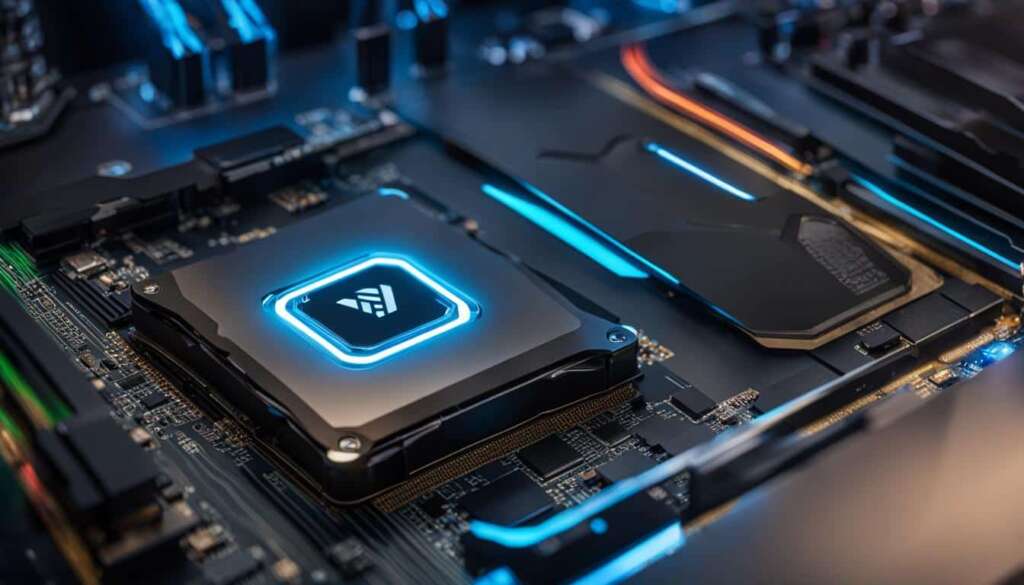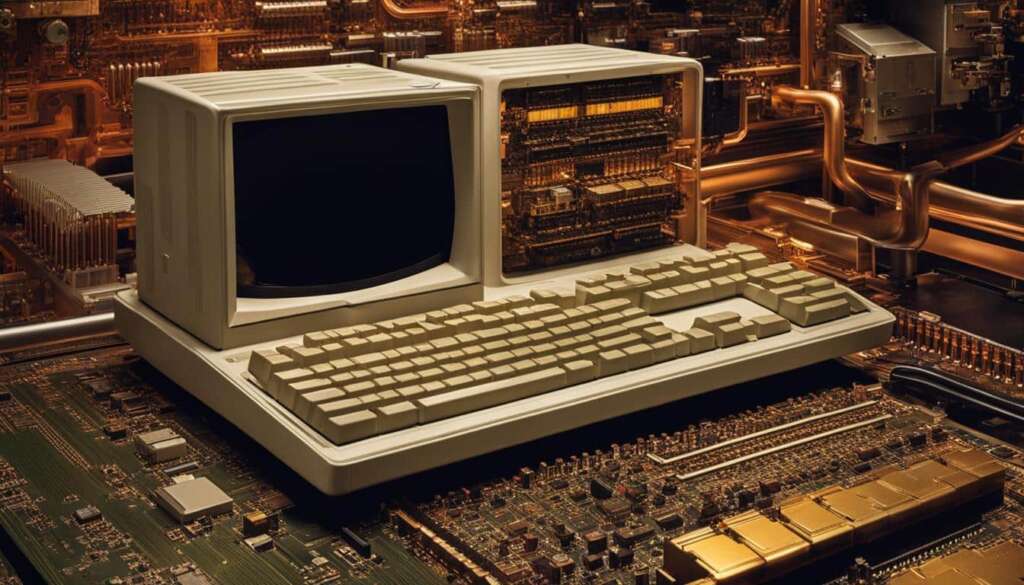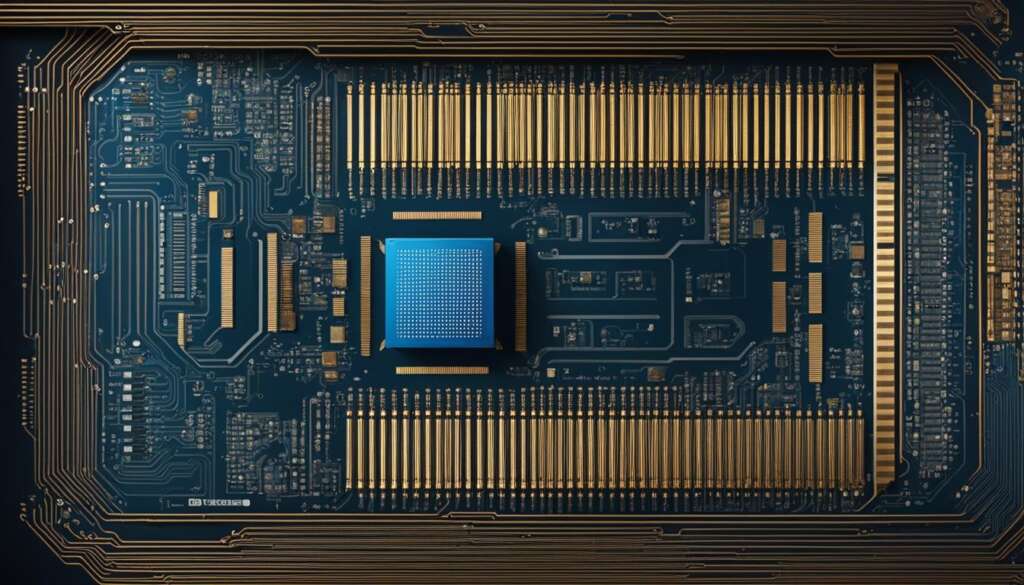Table of Contents
Open Source Processors, also known as CPU architecture, have been gaining significant traction in recent years. This emergence of open hardware has revolutionized the chip design community and sparked a wave of innovation in the industry. One of the most prominent examples of open source processors is RISC-V, a free and open-source processor design that has captured the attention of tech enthusiasts and industry leaders alike. With its collaborative chip design approach and open source software, RISC-V has paved the way for customization and hardware acceleration.
Open source processors offer a unique opportunity to break free from the constraints of proprietary architectures. Instead of being locked into a specific design or relying on licensed processor IP, developers can now collaborate and contribute to the evolution of processor technology. This open collaboration not only fosters creativity but also encourages the development of new and cutting-edge applications.
The impact of open source processors reaches far beyond the realm of traditional chip design. From IoT devices to data centers, the adaptability and flexibility of open source processors have allowed them to find applications in various industries. With the growing interest and investment in open source processors, the future of computing is set to be shaped by collaboration, innovation, and the limitless potential of open hardware.
The Origins of Open Source Processors: Berkeley RISC and RISC-V
The concept of open processors can be traced back to the groundbreaking work of the Berkeley RISC project in 1981. This project, led by David Patterson and Carlo H. Sequin, focused on designing reduced instruction set computing (RISC) architectures. The Berkeley RISC team published their research papers, which inspired subsequent projects and laid the foundation for the development of open-source processors. However, it was the launch of the RISC-V project in 2010 that truly brought open source processors into the mainstream.
RISC-V, developed at the University of California, Berkeley, is the most successful free and open-source processor architecture to date. What sets RISC-V apart is its free-as-in-speech nature. Unlike proprietary architectures, RISC-V can be implemented and modified by anyone without the need for royalties or license fees. This open design philosophy enables collaboration, innovation, and customization, making RISC-V the preferred choice for many developers and companies.
RISC-V has gained significant momentum in recent years and has garnered support from both academia and industry. The RISC-V Foundation, now known as RISC-V International, was established to drive the adoption and development of the RISC-V architecture. Today, RISC-V is used in a wide range of applications, from embedded systems to high-performance computing. Its open and adaptable nature has paved the way for a new era of collaborative chip design and has revolutionized the processor landscape.
| Key Points | Berkeley RISC | RISC-V |
|---|---|---|
| Architecture | RISC | RISC |
| Year of Inception | 1981 | 2010 |
| Developed at | University of California, Berkeley | University of California, Berkeley |
| Licensing | Proprietary | Open-source |
| Main Achievements | Inspired subsequent projects | Most successful open-source architecture |
The Growing Impact of Open Source Processors
The impact of open source processors, particularly RISC-V, is significant and far-reaching. These open-source processors offer numerous benefits that are driving the evolution of technology. Let’s explore some of the key advantages:
- Collaboration and Innovation: The open nature of these processors encourages collaboration among developers, leading to rapid development and customization. The collective knowledge and expertise of the community foster innovation and the creation of new ideas.
- Flexibility and Adaptability: Open source processors like RISC-V provide flexibility and adaptability, allowing developers to tailor the architecture to their specific needs. This makes them ideal for industries such as IoT, edge computing, and data centers, where customization and scalability are crucial.
- Cost-effectiveness: Open-source processors eliminate the need for expensive licensing fees, making them more accessible to a wider range of developers and startups. This cost-effectiveness lowers the barrier to entry and promotes greater participation in the development of processor IP.
With their potential to challenge traditional architectures and their ability to drive innovation, open source processors are reshaping the tech landscape. The benefits they offer, from collaboration and flexibility to cost-effectiveness, make them a compelling choice for developers and companies alike, leading to their increasing adoption across different industries.
“The open nature of these processors encourages collaboration among developers, leading to rapid development and customization.”
The Role of Open Source Processors in Tech Evolution
Open source processors are playing a pivotal role in the evolution of technology. As industries strive for increased performance, efficiency, and customization, open source processors offer the necessary tools and resources to meet these demands. The collaborative chip design community surrounding open source processors, particularly RISC-V, enables developers to share ideas, expertise, and advancements. This dynamic environment fosters innovation and the development of cutting-edge technologies in various fields.
Furthermore, the adaptability and scalability of open source processors make them ideal for emerging technologies such as IoT and edge computing. These processors provide the flexibility to meet the specific requirements of these applications, enabling seamless integration and optimal performance. Open source processors are also driving advancements in data centers, where the need for efficiency, scalability, and customization is paramount.
The Future of Open Source Processors
The future of open source processors, led by RISC-V, looks promising. With a growing ecosystem and increasing adoption, open source processors are poised to make a lasting impact on the technology landscape. As more companies and developers recognize the benefits and potential of these processors, investment and innovation in the field are expected to accelerate. Open source processors have the potential to transform the way we think about computing, driving collaboration, customization, and limitless possibilities.
Overcoming Challenges in the Open Source Processor Ecosystem
Open source processors, such as RISC-V, offer numerous benefits and opportunities for innovation. However, they also face challenges within the ecosystem that need to be addressed. One of the main challenges is the relatively recent emergence of RISC-V compared to established architectures like x86. As a result, the ecosystem around RISC-V is still developing, and there may be a lack of extensive support and resources.
Despite these challenges, the increasing adoption and investment in RISC-V are gradually overcoming the limitations. Companies and developers are recognizing the potential of open source processors, and they are actively contributing to the growth of the ecosystem. The collaborative efforts of the chip design community are expanding the resources and support available for RISC-V, making it a more viable and attractive option for a wide range of applications.
Additionally, the open nature of RISC-V encourages innovation and customization. Developers have the freedom to modify the architecture to meet specific requirements, leading to unique and tailored solutions. As more companies and individuals embrace the possibilities of open source processors, the ecosystem will continue to thrive and evolve, further overcoming the challenges that exist.
The Importance of Collaboration
An essential aspect of overcoming challenges in the open source processor ecosystem is collaboration. By working together, developers can leverage their collective knowledge and resources to address the limitations and push the boundaries of open source processor technology.
Collaboration not only helps to improve the ecosystem, but it also fosters innovation by bringing together diverse perspectives and expertise. When different companies and individuals collaborate, they can contribute their unique insights and ideas, ultimately leading to better solutions and advancements in open source processor technology.
“Collaboration is the key to unlocking the full potential of open source processors. By working together, we can overcome the challenges and create a vibrant ecosystem that fosters innovation and drives the future of computing.”
As the open source processor ecosystem continues to grow and mature, collaboration will play a crucial role in expanding its capabilities and addressing any remaining challenges. By embracing open collaboration, the chip design community can ensure that open source processors like RISC-V continue to thrive and revolutionize the technology landscape.
Open Source Processor Applications: From IoT to Data Centers
Open source processors, particularly RISC-V, have a broad spectrum of applications. They are already widely used in embedded systems, IoT devices, and edge computing. Additionally, they are gaining traction in data centers and high-performance computing. The adaptability and customization of open source processors make them suitable for various industries and use cases, ranging from small IoT devices to large-scale data centers.
In IoT applications, open source processors offer several advantages. They enable developers to create cost-effective and highly efficient solutions for connected devices. The flexibility of open source architectures allows for customization to meet specific requirements, ensuring optimal performance and functionality. Moreover, open source processors foster innovation and collaboration, driving advancements in IoT technology.
In data centers, open source processors like RISC-V are increasingly being adopted for their scalability and power efficiency. These processors can handle the demands of complex workloads and parallel processing, making them well-suited for big data analytics, artificial intelligence, and machine learning applications. The open nature of RISC-V also allows data center operators to optimize the architecture to meet their specific needs, resulting in improved performance and cost savings.
Table: Applications of Open Source Processors
| Industry | Applications |
|---|---|
| IoT |
|
| Data Centers |
|
| Embedded Systems |
|
| Edge Computing |
|
Open source processors offer unparalleled flexibility and customization, making them ideal for a wide range of applications. From small IoT devices to large-scale data centers, these processors provide the performance and efficiency required in today’s technology-driven world. As the open source processor ecosystem continues to grow, we can expect even more innovative and transformative applications to emerge.
Open source processors, like RISC-V, are driving the evolution of technology by enabling collaboration, innovation, and customization. With their broad applications and growing adoption, open source processors are poised to shape the future of computing, empowering industries and individuals to create advanced solutions that meet their specific needs. As technology continues to advance, open source processors will play a pivotal role in enabling the next wave of technological breakthroughs.
The Maker Community and Open Source Processors
The maker community has embraced open source processors, especially RISC-V. Initially, experimentation was limited due to a lack of silicon implementations. However, companies like SiFive and Espressif Systems have introduced RISC-V chips and boards, making it more accessible to makers. The open nature of RISC-V allows makers to explore and customize the architecture, fostering creativity and learning in digital design and computer architecture.
With the availability of RISC-V boards and resources, makers can now embark on exciting projects that leverage the power and flexibility of open source processors. From building custom IoT devices to creating innovative edge computing solutions, the maker community is driving the exploration and application of open source processors in various domains.
By harnessing the potential of RISC-V, makers can push the boundaries of what is possible and contribute to the continuous development and improvement of open source processors. The collaborative spirit within the maker community aligns perfectly with the open source philosophy, creating a vibrant ecosystem of shared knowledge and innovation.
Empowering Makers with RISC-V
- Access to RISC-V chips and boards for experimentation
- Customization and personalization of processor architectures
- Opportunity for creative projects and inventions
- Collaborative learning and knowledge sharing within the maker community
Table: Comparison of RISC-V Chips for Makers
| Chip | Description | Price |
|---|---|---|
| SiFive FE310-G003 | A popular RISC-V chip for embedded applications | $8 |
| Espressif ESP32-C3 | RISC-V based Wi-Fi and Bluetooth chip | $1.20 |
| Pine64 PINEBOOK Pro | Open source laptop with RISC-V support | $199 |
These chips offer a range of features and price points, allowing makers to choose the best fit for their projects. Whether it’s building a small embedded system or developing a full-fledged open source laptop, the availability of these chips empowers makers to turn their ideas into reality.

The Future of Open Source Processors
As open source processors, especially RISC-V, continue to gain momentum, the future prospects for this innovative technology look promising. With their open and collaborative nature, open source processors have the potential to shape the future of computing. Companies and developers are increasingly recognizing the benefits of open source processors, driving investment and advancement in this field.
RISC-V, in particular, is experiencing dynamic growth and evolution within its ecosystem. As new extensions and capabilities are regularly added, the architecture expands its reach into new markets and applications. This constant innovation and flexibility make RISC-V an attractive choice for industries such as AI, machine learning, IoT, and connected cars.
Open source processors also offer start-ups and small chip companies significant advantages. The royalty-free nature of RISC-V enables cost-effective development, removing barriers for secure and efficient cryptography in IoT devices. Additionally, the simplicity and flexibility of RISC-V designs allow start-ups to customize their processors without the burden of licensing fees, providing them with opportunities in various sectors, including automotive and IoT.
Advancements and Impact
The future of open source processors lies in their ability to drive collaboration, innovation, and limitless potential. With the continuous development of the RISC-V ecosystem and the increasing acceptance of open source processors, exciting advancements are on the horizon. The global reach of RISC-V, the growing membership of organizations like RISC-V International, and the expanding applicability of open source processors across industries all contribute to a future where open collaboration and customization are key drivers of technology evolution.

| Benefits of Open Source Processors | Future Prospects |
|---|---|
| Promote collaboration and innovation | Continued growth and adoption |
| Adaptability and flexibility for various industries | Exciting advancements in the coming years |
| Cost-effective development for start-ups | Expansion into new markets and applications |
| Customization without licensing fees | Limitless potential for technology evolution |
“Open source processors are revolutionizing the technology landscape and shaping the future of computing.”
The future of computing lies in the collaborative and innovative spirit of open source processors. As the RISC-V ecosystem continues to grow, the possibilities for customization and advancement are endless. Open source processors have the potential to drive the evolution of technology across industries and empower start-ups to create the next generation of innovative solutions.
The Growth and Impact of RISC-V International
RISC-V International, the non-profit organization behind RISC-V, has experienced significant growth and impact. Membership in the organization has increased by 130% in 2021, with major tech companies like Google joining the ranks. This expansion of membership reflects the growing acceptance and adoption of open source processors and the potential they hold for the future of computing.

RISC-V chip revenues are projected to reach $1 billion by 2024, underlining the financial viability and market potential of open source processors. This growth showcases the increasing confidence in RISC-V as a competitive alternative to traditional proprietary architectures. As more companies recognize the benefits of open source collaboration and innovation, they are actively investing in RISC-V, contributing to its continued growth and impact.
The impact of RISC-V International extends beyond membership and revenue growth. By fostering an open and collaborative ecosystem, the organization promotes knowledge sharing, innovation, and the development of new technologies. Its global reach and diverse membership base facilitate the exchange of ideas and best practices, driving advancements in chip design and processor architecture.
The Benefits of Open Collaboration in RISC-V
The open collaboration in the RISC-V community has revolutionized the development and innovation of open source processors. Through this collaborative approach, developers from around the world have contributed to the creation and ratification of numerous specifications, expanding the reach of RISC-V into new markets and applications.
RISC-V’s open collaboration model allows for the easy exchange of ideas and knowledge among developers, enabling the continuous improvement and evolution of the architecture. The open and transparent nature of RISC-V promotes innovation, encourages experimentation, and accelerates the development of new features and technologies.
This open collaboration has resulted in the creation of specifications covering various areas, including vector, scalar cryptography, and hypervisor features. These specifications provide developers with the tools and resources to create RISC-V applications for a wide range of industries, from AI and machine learning to IoT and connected cars.
The open collaboration in the RISC-V community has fostered a culture of innovation, where developers can freely contribute their expertise and collectively push the boundaries of what is possible in processor design.
By embracing open collaboration, RISC-V has transformed the processor landscape, offering a flexible and customizable alternative to traditional proprietary architectures. This collaborative approach not only benefits individual developers and companies but also drives the advancement of the entire open source processor ecosystem.
The Power of Open Collaboration
RISC-V’s open collaboration model has enabled developers to leverage the collective intelligence and skills of the community, resulting in faster and more efficient development cycles. The open specifications and continuous collaboration ensure that RISC-V remains at the cutting edge of processor design and technology.
- Developers can freely access and modify the RISC-V architecture, enabling customization and tailoring to specific use cases and requirements.
- The open collaboration model encourages the sharing of best practices, resulting in improved designs, optimizations, and overall performance of RISC-V processors.
- Open collaboration also facilitates the identification and resolution of bugs and vulnerabilities, ensuring a more secure and reliable ecosystem.
This open collaboration extends beyond the software layer, with companies and organizations collaborating on hardware designs and implementations. This collective effort has led to the development of RISC-V chips and boards, making the technology more accessible and available to a broader audience.
| Open Collaboration Benefits | Implications |
|---|---|
| Increased innovation and customization | Enables developers to create unique and tailored solutions |
| Accelerated development cycles | Allows for faster iterations and improvements in processor design |
| Sharing of best practices | Leads to optimization and enhanced performance of RISC-V processors |
| Identification and resolution of bugs and vulnerabilities | Ensures a more secure and reliable ecosystem |
The power of open collaboration in RISC-V is transforming the processor industry, empowering developers to create innovative solutions and driving the adoption of open source processors worldwide. With open collaboration at its core, RISC-V is poised to shape the future of computing and enable a new era of customization and flexibility in processor design.
RISC-V’s Advantages and the Appeal to Startups
Advantages of RISC-V for Startups
RISC-V offers numerous advantages that make it particularly appealing to startups and small chip companies. Its royalty-free open-source architecture allows for cost-effective development, removing barriers and reducing upfront costs. This is especially crucial for startups with limited resources, as it enables them to allocate their budget more efficiently. With RISC-V, startups can focus on innovation and customization without the burden of licensing fees, accelerating their time to market and providing a competitive edge.
One of the key advantages of RISC-V is its simplicity and flexibility. The modular design of RISC-V allows developers to choose the specific features and extensions they need for their application, optimizing performance and power efficiency. This level of customization empowers startups to tailor their processors to meet the unique requirements of their target market, enabling differentiation and innovation. It also allows for easy integration with other open-source software and hardware, fostering collaboration and interoperability.
The Appeal of RISC-V to Startups
RISC-V’s open and collaborative ecosystem is another factor that appeals to startups. The active community and vibrant ecosystem provide startups with access to a wealth of resources, knowledge, and support. Startups can tap into the collective expertise and learn from experienced developers and industry leaders, gaining valuable insights and guidance. Additionally, the open nature of RISC-V encourages collaboration, allowing startups to leverage existing work and build upon the contributions of others. This collaborative environment fosters rapid innovation and accelerates the pace of development.
Furthermore, RISC-V’s growing adoption and industry support create a favorable business environment for startups. As major tech companies and established players embrace RISC-V, it gains credibility and recognition in the market. This increases confidence among potential investors and partners, making it easier for startups to secure funding and partnerships. The expanding market for RISC-V processors in sectors such as automotive, IoT, and edge computing presents significant growth opportunities for startups willing to ride the wave of open-source innovation.
| Advantages of RISC-V for Startups | The Appeal of RISC-V to Startups |
|---|---|
| • Cost-effective development with royalty-free architecture | • Access to a supportive community and vast resources |
| • Simplified customization and optimization for specific applications | • Collaborative environment for rapid innovation |
| • Integration with other open-source software and hardware | • Increased credibility and market recognition |
| • Potential for differentiation and competitive advantage | • Growth opportunities in emerging sectors |
The Global Reach of RISC-V
RISC-V, the open-source processor architecture, has achieved a truly global reach, with a diverse membership base spanning North America, Europe, and Asia. This global presence is demonstrated by the recent transfer of RISC-V International’s headquarters to Switzerland, emphasizing its commitment to independence and facilitating collaboration across borders. The appeal of RISC-V’s open and inclusive approach extends to companies worldwide, including those in China affected by export restrictions. By fostering a global chip design community, RISC-V encourages the exchange of ideas and drives innovation on a global scale.
RISC-V’s global reach is not only geographical but also extends to its impact on industries around the world. Companies of all sizes, from startups to tech giants, are embracing RISC-V for its flexibility, customization options, and cost-effectiveness. The architecture’s royalty-free nature and open collaboration allow startups to innovate and develop their own processors without the burden of licensing fees. At the same time, major tech companies are recognizing the potential of RISC-V and joining the RISC-V International organization, contributing to its growth and impact.
With its global reach and widespread adoption, RISC-V is poised to shape the future of computing. The open nature of the architecture, combined with the active participation of a diverse range of companies and developers, fuels ongoing advancements and drives the evolution of technology. As the RISC-V ecosystem continues to expand, exciting possibilities emerge for industries ranging from IoT to data centers, where the adaptability and customization of RISC-V processors offer new opportunities for innovation and growth.
| Region | Membership |
|---|---|
| North America | 45% |
| Europe | 35% |
| Asia | 20% |
Table: Regional Distribution of RISC-V International Membership
Conclusion
Open source processors, particularly RISC-V, are revolutionising the technology landscape. The rise of open collaboration and innovation has led to the growth and adoption of RISC-V, with significant impact across various industries. As the RISC-V ecosystem continues to develop, exciting advancements are expected in the future of computing. The limitless potential and broad applications of open source processors make them a key area to watch for technology enthusiasts and industry leaders alike.
FAQ
What is the RISC-V project?
The RISC-V project is a free and open-source architecture that allows for collaboration, innovation, and customization in processor design.
How does RISC-V differ from traditional proprietary architectures?
Unlike traditional proprietary architectures, RISC-V is free and open-source, meaning anyone can implement and modify the architecture without royalties or license fees.
What industries are adopting RISC-V?
RISC-V is being adopted in various industries, including smartwatches, IoT devices, edge computing, data centers, and high-performance computing.
What challenges do open source processors like RISC-V face?
One of the main challenges is the relative novelty of RISC-V compared to established architectures, resulting in a less extensive ecosystem and support. However, this is gradually being addressed as adoption and investment in RISC-V grow.
What are the advantages of open source processors like RISC-V for startups?
Open source processors like RISC-V offer startups cost-effective development, as they can innovate and customize their processors without the burden of licensing fees.
How does the openness of RISC-V appeal to the maker community?
The open nature of RISC-V allows makers to explore and customize the architecture, fostering creativity and learning in digital design and computer architecture.
What does the future hold for open source processors?
The future of open source processors, led by RISC-V, looks promising. The architecture is expected to witness exciting advancements as more companies and developers invest in its development.
What is RISC-V International?
RISC-V International is a non-profit organization behind RISC-V, which has experienced significant growth and impact. It has a diverse membership base and aims to drive the adoption and advancement of open source processors.
How does open collaboration benefit the development of RISC-V?
Open collaboration in the RISC-V community leads to the development and ratification of specifications, expanding the reach of RISC-V into new markets and applications, fostering innovation and collaboration.
Why is RISC-V appealing to startups and small chip companies?
RISC-V’s royalty-free open-source architecture allows for cost-effective development and removes barriers for secure and efficient cryptography in IoT devices. Its simplicity and flexibility enable startups to innovate and customize their processors without licensing fees.
How does RISC-V have a global reach?
RISC-V has a diverse membership base from North America, Europe, and Asia. Its headquarters transfer to Switzerland ensures its independence and global presence, appealing to companies worldwide.


